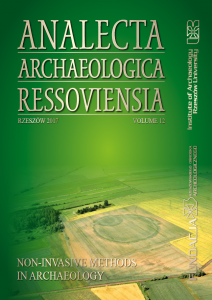Knowing Without Digging? Non-invasive Research of the Krzczonów Earthwork and its Surroundings
DOI:
https://doi.org/10.15584/anarres.2017.12.11Słowa kluczowe:
Krzczonów, non-destructive archaeology, motte-type castle, Late Medieval Period, Early Modern PeriodAbstrakt
The topic of this paper is a non-invasive research case study of a protected monument mound in Krzczonów, Świętokrzyskie voivodeship in Lesser Poland. It explores the possibilities of non-invasive methodological approaches in the recognition of archaeological sources by asking whether it is possible to procure relevant information without conducting excavations. A new interpretation of the mound’s function and chronology is based on data derived from multi-method field surveys including remote sensing (satellite imagery, UAV, light aircraft, ALS), geophysical (magnetic gradiometry, earth resistance), total station measurements and analytical field walking prospection along with comparison of archival field-walking data. We would like to hypothesize that, contrary to the protected monument list, the Krzczonów earthwork is not a prehistoric feature but could be related to the end of 14th up to the beginning of the 16th century. In this case it could be understood as a remnant of a motte-type castle.

